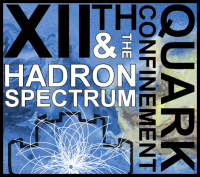Speaker
Description
By β-decay a Neutron transforms into a Proton and emits a Positron and a Neutrino. The latter only interacts weakly. During Neutron Star formations and mergers, we have a high Neutrino flux, which can be measured. Therefore by Neutrino measurement, we can learn about the inner structure of Neutron Star formations and mergers. Because during these processes the matter is dense, we have a back coupling of Neutrinos with the matter. Thus for a better understanding, it is necessary to analyze strong and weak interactions in a coupled non-perturbative way. We choose Dyson-Schwinger-Equations as our method and evaluate QPs in a first step. Due to the presence of the weak interaction, quarks can propagate from one flavor in to the other and thus we have in addition to QPs for pure flavors also QPs for mixed flavors. Thus the Dyson-Schwinger-Equations for the QPs in particular for the mixed flavor have additional contributions to the self energy, which can be diagrammatically represented by a loop graph for emitting and absorbing weak gauge bosons. In the first step, the loops in these graphs are approximated by point interactions. For the strong interaction we used the Rainbow truncation with the Maris-Tandy coupling. The QPs for pure and mixed flavor are calculated in the chiral limit and for physical quark masses of all three generations. Because of parity violation the QPs have in addition to the usual vector- and scalar channels also axial- and pseudo-scalar channels. We find different contributions to the QPs coming from dynamical and explicit chiral symmetry breaking. Furthermore we have, due to the Iso-Spin breaking, also contributions arising from mass splitting of the quarks. We analyze the effect of the different contributions on the parity breaking.
Summary
We analyze strong and electroweak interactions using Dyson-Schwinger-Equations. Due to the weak interaction, the quark propagators (QPs) have additional contribution to the self energy, due to emission and absorbing of weak gauge bosons. In the first step the exchange of weak gauge bosons are approximated by point interactions and for the strong interaction the Rainbow truncation is used. In this case we also have mixed flavors, because quarks can change flavor due to the weak interaction. Because of parity violation the QPs have in addition to the usual vector- and scalar channels also axial- and pseudo-scalar channels. The QPs are calculated in the chiral limit and for physical quark masses of all three generations. Dynamical and explicit breaking of the chiral symmetry and in particular mass splitting of quarks have different effects on the parity breaking, which is explicitly analyzed.
